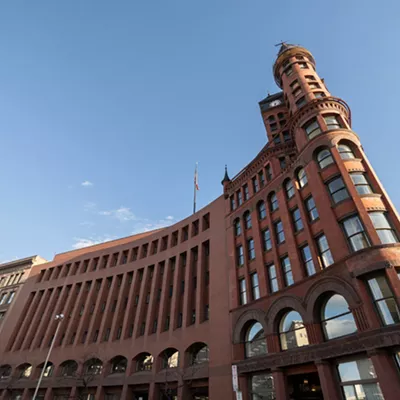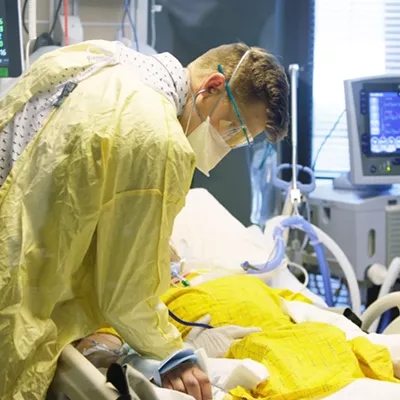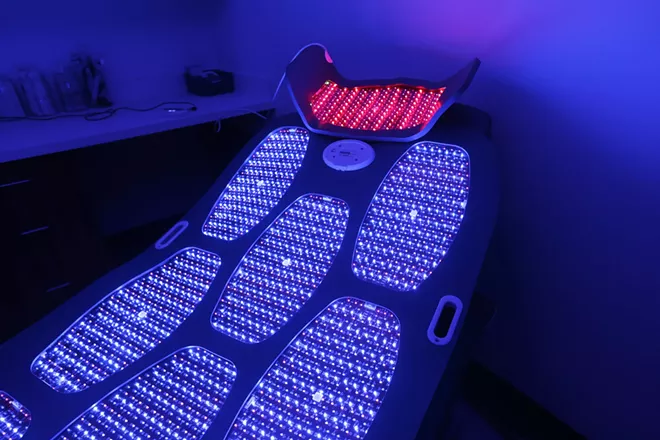
Can different colors of light really do everything from reduce wrinkles to reverse potentially cancerous sun damage? Surprisingly, the answer is yes.
Decades of research has shown that different wavelengths of light can be used in a targeted way to kill precancerous cells, induce collagen production (providing that youthful look), and even help bones and wounds heal faster and reduce chronic pain.
While it may sound like a new-age snake oil — a too-good-to-be-true cureall — some of the more modern trends in light therapy have their roots in NASA research. In the early '90s, NASA-partnered scientists stumbled upon the healing properties of LEDs while studying whether light-emitting diodes could help plants grow in space. While working with the lights, the researchers noticed that abrasions on their hands were healing faster than normal.
After that, NASA wanted to study whether red or blue light could help astronauts heal in low- to no-gravity situations, which slow cell growth and make even small wounds hard to heal. The government space agency tested LEDs with the U.S. Navy, and learned that high-intensity red light and near-infrared light treatments helped heal service members' musculoskeletal training injuries 40 percent faster than a control group, and lacerations healed 50 percent faster.
LEDs require far less energy than laser light treatments and can cover more of the body without the risk of tissue damage that comes with laser treatments. While laser treatments often need to be performed by medical professionals, LEDs have no side effects and don't require healing time, opening them up to a broad audience for various uses.
Some light therapy is known as photobiomodulation — "photo" meaning light, and "biomodulation" meaning making changes to the cells — explains Cameron Chesnut, a facial plastic surgeon and owner of Clinic 5, a medical practice with offices in the Spokane area.
Different wavelengths, like red light, can travel deeper inside the body, he says.
"It's a way of delivering energy deeper into our tissue," Chesnut says. "The trick is the different cells respond differently to that energy."
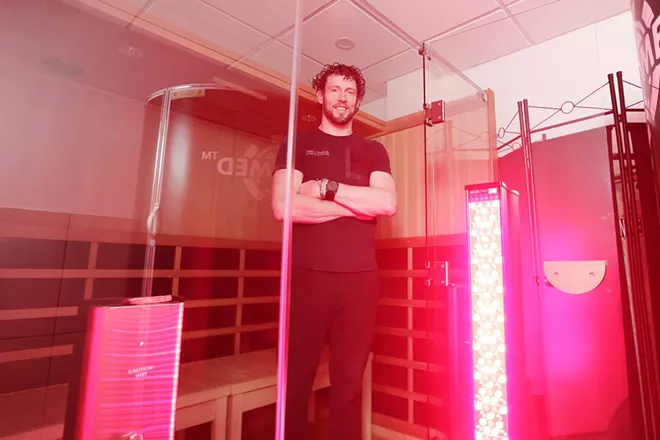
RED LIGHT
Perhaps the trendiest light therapy featured on social media in recent years is the promise of red light therapy to give skin a more youthful appearance.
Red light penetrates deep into the body and cells to boost energy and help stimulate collagen and elastin production. But both doctors and aestheticians warn that no one should be expecting instant or miraculous results.
The therapy works best if used regularly over time, and often a specific treatment plan is necessary to figure out which wavelengths and duration work best.
To get the most dramatic results, doctors may also recommend starting with a more invasive procedure, with red light therapy used afterward to boost healing.
"The daily driver use of red light falls a little bit short versus using it in a therapeutic fashion for recovery," Chesnut says. "I'm not saying there's no benefit without stimulus, but it's significantly less. When paired with laser treatment or microneedling, you will get more bang for your buck. Red light therapy helps with the healing process by modulating inflammation, and it also improves the long-term results of that treatment."
Still, there are options available that don't require invasive procedures.
At-home light masks run the gamut from cheaper options with fewer LEDs, to high-end face and neck pieces with more than 1,000 LEDs.
The Omnilux Contour Face mask is $395, has FDA approval and clinical studies to back it up, and uses 132 medical-grade LEDs to treat the skin with red and near-infrared light.
Pricier options include masks like the Korean-designed Artemis, which runs about $4,000 for a face and neck piece that can use a variety of red, blue, green and yellow light frequencies to treat everything from dyspigmentation to fine lines. The mask combo can be controlled through an app, has 1,080 LEDs, and has CE certification, meaning it meets European Union health standards.
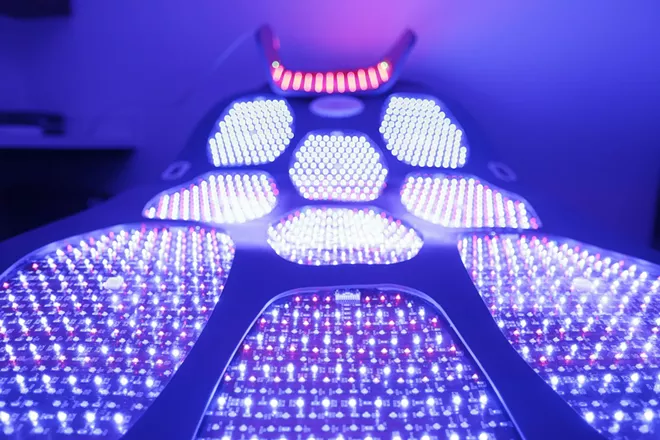
MULTIFREQUENCY TREATMENT
Other light therapy options in Spokane include Di' Amand Salon's high-end photobiomodulation light bed, which was specially ordered from Serbia.
Di' Amand owner Tara Smith says the bed looks similar to a tanning bed, but its multispectrum treatments can address a wealth of issues, from chronic pain to athletic injuries and inflammation. Some clients use it to achieve firmer skin, and others use it to boost their mood, with some reporting that they feel more energized after using it, Smith says.
"We have a lot of people who use it for pain relief," Smith says. "I work with a lot of athletes."
The bed blinks between blue light, red light and near-infrared light, using thousands of LEDs, and sessions usually last about 25 minutes, Smith says.
She works with clients to schedule sessions so they're most likely to benefit from the bed, typically starting out with three sessions a week for four weeks, and tapering down after that to maintain the benefits. She tries to make sure that people know not to expect results after just one time of using the bed.
"Some are blown away after one session, but someone who is healthy might not notice anything until they've used it a couple times," Smith says. "It's basically like jump-starting your little energy packs in your cells, your mitochondrial level."
BLUE LIGHT AND GREEN LIGHT
In dermatology clinics, blue light is often used to treat acne because it has antibiotic properties.
"Blue light is a great treatment for facial acne," Chesnut says. "It's more treating that bacterial cause than it is working on our own skin."
Certain wavelengths in the blue light spectrum are also used in conjunction with medical creams to treat precancerous sun damage on the skin through what are called photodynamic treatments. That treatment is offered by many dermatologists, including at Dermatology Specialists of Spokane.
Green light sits in the middle of the spectrum of visible light, and is more of a jack of all trades and master of none, Chesnut says.
"It doesn't penetrate as deep," Chesnut says. "It does get used for middle of the spectrum dyschromia, but it doesn't work very well compared to other types of treatment."
Chesnut says he often uses laser treatment to address pigmentation issues near the surface of the skin.
COMMON QUESTIONS
Does LED light therapy require eye protection?
No. When it comes to LEDs, eye protection isn't necessary, particularly with red light treatment, although many places that offer those services provide goggles for client comfort.
However, for other light therapies like laser treatments, eye protection is essential. Facial plastic surgeon Cameron Chesnut says he puts metal eye contacts on the patients he treats with laser therapy to ensure their eyes are well protected.
Does LED light therapy hurt?
Unlike laser treatments, which can cause discomfort and require healing time from 24 hours to several days or more, LEDs are a painless option that aren't known to require any healing time or cause any negative side effects.
Does it work? Why would you need to undergo multiple treatments?
Because LED therapy is far less powerful, it often requires regular sessions (sometimes 10 minutes to 25 minutes per day, multiple days a week) to actually see an improvement.
"I think people think they'll put a red light on their face for three months or four months and have brand new skin. That's not how it works," Chesnut says. "It's more of a maintenance than a treatment."
Are at-home options safe?
The good news, Chesnut says, is that it's unlikely that any red light LED masks you can buy will be dangerous for your skin. But if a mask isn't using the right frequency or power, it may not be effective.
"The greatest risk is they're going to get something that's not going to work very well, rather than going to get something damaging," Chesnut says. "For at home use, I usually have a pretty deep conversation with my patients."









